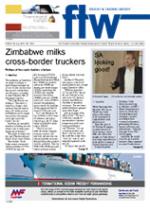Ten months since the
official launch of the
Port of Ngqura, the latest
figures show business
developing at a satisfying
pace, according to Siya
Mhlaluka, the executive
manager for Eastern Cape
Terminals.
“The number of
scheduled ships now
calling each week has
grown significantly,” he
told FTW. “Previously we
were handling two vessels
a week, with a payload
average of 700-TEUs. Now
we are handling an average
of seven vessels per week
– at an average size of
950-TEUs – operated by
Mediterranean Shipping
Company (MSC) and
Mitsui OSK Line (MOL).”
The average loading/
unloading time for
each ship is 24-hours.
“It obviously varies
depending on the number
of containers,” Mhlaluka
added.
The terminal is now
averaging 22 000-TEUs
per month, according to
the latest port stats – 50%
of this is transhipment,
with exports and imports
accounting for 24% and
26% respectively.
The inland transport
system to/from the port
uses both rail and road
modes, and is capably
handling the traffic volume
at the port. According to
Mhlaluka, the needs are
currently being serviced
by two trains per day
between Gauteng and Port
Elizabeth, while the truck
number has grown to match
the needs, from 1 300
trucks a month to 5 600.
He also noted that what
he described as “a massive
growth” in volumes was creating a challenge for the
port.
“Things are growing
so fast,” he added, “that
the number of containers
supersedes the current
number of operating
staff. But the terminal is
currently accelerating its
resources plan, boosting
the work-force from the
present three gangs to
five gangs by the end of
September.”
The computer port
system being used is the
latest programme installed
by Transet – the Navis
system – and Mhlaluka
modestly described it as
“satisfactory”.
But one of the lines
using the port was more
complimentary.
Discussing Ngqura
with FTW, Iain McIntosh,
national marketing
manager for MOL, said:
“The port is state-of-theart,
and all-electronic,
so there’s none of the
old nuisance of paper
documents.
“There’s also a fantastic
control room, which is
also state-of-the-art – well
up to European and Asian
standards, which means
that the productivity levels
are very good.”
Questioned on his
current expectations about
the future at Ngqura,
Mhlaluka said that the port
was currently extending
berth quay length from
640-metres to 740-m.
“This,” he added, “will
enable 305-m length
vessels to berth in tandem.”
Ngqura boosts workforce to cater for growing volumes
30 Jul 2010 - by Staff reporter
0 Comments
FTW - 30 Jul 10

30 Jul 2010
30 Jul 2010
30 Jul 2010
30 Jul 2010
30 Jul 2010
30 Jul 2010
30 Jul 2010
30 Jul 2010
30 Jul 2010
30 Jul 2010
